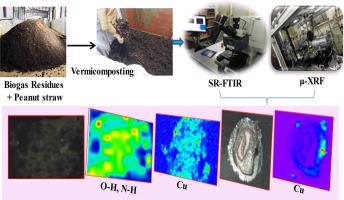Waste Management ( IF 8.1 ) Pub Date : 2020-06-04 , DOI: 10.1016/j.wasman.2020.05.036 Fu-Sheng Sun 1 , Guang-Hui Yu 2 , Xiang-Yang Zhao 3 , Matthew L Polizzotto 4 , Yu-Jun Shen 5 , Hai-Bin Zhou 5 , Xi Zhang 5 , Ji-Chao Zhang 6 , Xiao-Song He 7

|
Biogas residues (BR) contaminated with potentially toxic metals pose environmental risks to soils and food chains, and strategies are needed to decrease the concentration and bioavailability of potentially toxic metals in BR. Here, metal fractions and removal mechanisms were quantified by synchrotron radiation-based Fourier transform infrared and micro X-ray fluorescence spectromicroscopies on BR and earthworms subject to vermicomposting. Vermicomposting resulted in decreases in concentrations of potentially toxic metals in BR and increases in metal removal efficiencies due to uptake by earthworms. Prior to vermicomposting, Zn, Cu and Pb were associated with N-H, O-H, aromatic C, aliphatic C, and amide functional groups, but following maturation during vermicomposting, metals were associated with N-H, O-H, aliphatic C and polysaccharide functional groups. Following vermicomposting, Zn and Cu were mainly distributed in the dermal portions of earthworms, whereas Pb was more homogeneously distributed among the inner and outer portions of the earthworms, revealing that different metals may have different uptake routes. These findings provide a new strategy for safe utilization of BR by using earthworms via vermicomposting to remove potentially toxic metals and in situ insights into how metals binding and distribution characteristics in BR and earthworms during compost and vermicomposting processes.
中文翻译:

通过基于同步加速器辐射的光谱显微镜揭示了通过ver堆肥从沼气残渣中去除潜在有毒金属的机理。
被潜在有毒金属污染的沼气残留物(BR)对土壤和食物链构成环境风险,因此需要采取策略降低BR中潜在有毒金属的浓度和生物利用度。在此,通过基于同步加速器辐射的傅立叶变换红外和微X射线荧光光谱法对BR和earth进行ver污处理后的金属含量和去除机理进行了定量。com堆肥导致BR中潜在有毒金属的浓度降低,并且由于earth的吸收而提高了金属去除效率。在ver浆之前,Zn,Cu和Pb与NH,OH,芳族C,脂族C和酰胺官能团相关,但在ver浆过程中成熟后,金属与NH,OH,脂族C和多糖官能团。ver堆肥后,Zn和Cu主要分布在worm的真皮部分,而Pb则更均匀地分布在worm的内部和外部,这表明不同的金属可能具有不同的吸收途径。这些发现为using的using涂技术提供了一种安全利用BR的新策略,可通过ver涂去除潜在的有毒金属和就堆肥和ver堆肥过程中金属在BR和earth中的结合和分布特性进行现场观察。



























 京公网安备 11010802027423号
京公网安备 11010802027423号